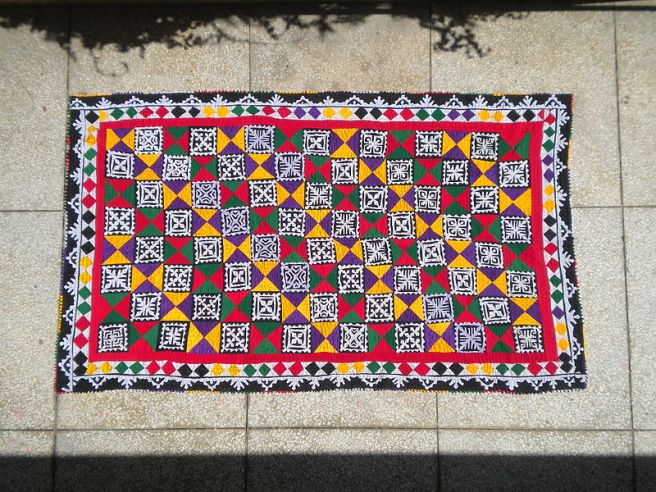
Rillis are not only beautiful, they are warm, they are artistic, and they offer economic opportunity for women that are not dependent on weather or other circumstances external to the home.
By Marilyn R. Gardner
From the time I can remember we had two types of quilts in our home. One type was lovingly made by women in churches in the United States, given periodically to my parents as gifts for their home in the far away land of Pakistan – a land understood by church goers primarily through slide shows and the eyes of my parents. I am convinced those quilts were made with prayer and our good in mind. The quilts were hand crafted so well, and provided such warmth, that this past year two of my children absconded with a couple of them as a means of comfort against Chicago and New York winters.
The others were completely different, from pattern, to fabric, to the circumstances of those making the quilts – they were Sindhi rillis. Sindhi rillis are generally of brighter colors than the more muted choices of quilters in the United States and the patterns are more complicated and geometric. They graced beds, couches, floors and even served as picnic blankets throughout my life in Pakistan. Rillis are not only beautiful, they are warm, they are artistic, and they offer economic opportunity for women that are not dependent on weather or other circumstances external to the home.
Rillis, like many crafts in Pakistan, are made for practical use and the creator doesn’t realize how beautiful and unique they are. Like many things in my childhood, I didn’t always realize how beautiful they were. As I went into junior high I began favoring the synthetic, fluffy, comforters, purchased on sale out of a Sears catalogue, made not for warmth but for show. My mother kindly conceded to this (and I might add other requests reflecting my age) probably thinking “what a waste” but allowing me this “all things American are better” attitude, recognizing I would outgrow it. Future interactions had me expressing the opposite view of “all things away from America are better” until the pendulum settled in the middle. The point it, I didn’t see rillis for what they were – a beautiful craft, skillfully created with minimal materials and maximum ingenuity.
My appreciation for rillis grew as I got older. The difficult patterns and stitches executed by women in villages who were illiterate amazed me. This weekend I saw a clip of a YouTube video from a friend that shows a beautiful slide show of rillis accompanied by music. It brought me once again across the ocean to a different place and time. Most of all it took me back to the women behind the rillis – women who were true entrepreneurs in their homes and villages. It also brings me back, in gratefulness, to my childhood and the warmth, beauty and comfort that I experienced, so well represented by the Sindhi rilli.
_____________________
Comment by Bettie Addleton
Thanks Marilyn for showing this beautiful art. Not only have these quilts warmed up many a cold winter night, but the intricate and artistic applique designs found their way to haute couture, splashing many a khameez with color and beauty. Interior designers delighted in throwing some of this fascinating art into their designed rooms, etc.( I once ordered specific color combinations for a couple of women interior designers.) Now and then I’ve spotted the rillis or cushion covers in various magazines. I feel pride when I think of the women, often illiterate, who patiently cut those myriad of designs, sewed the appliques together, and then quilted them with hundreds of small stitches. Warm memories of the past!!
[author title=”Marilyn R. Gardner” image=”https://sindhcourier.com/wp-content/uploads/2021/06/Sindhi-Rilli-Marilyn-Gardner.jpg”]The Blogger Marilyn Gardner, a public health nurse and writer who lived between worlds, but mostly in Boston, was raised in Pakistan and went on to raise her children in Pakistan and in Egypt. She began writing in 2011 after participating in a humanitarian aid trip to Pakistan. Revisiting her childhood home and working in relief effort awakened a long dormant desire to communicate what it was to live between worlds. “My writing and speaking come from a place of knowing what it means to live between. I have participated in humanitarian relief trips to Pakistan, Iraq, Jordan, and Lebanon. In 2018, my husband and I moved to Northern Iraq where we lived in a small city and taught at a public university. This experience gifted me with a love for the people and place of Kurdistan,” she tells about her life. ‘Communicating Across Boundaries’ is a blog about communicating across faith and cultural boundaries. Topics include everything from thoughts on culture, third culture kids, faith, and communicating cross culturally. Marilyn, who is also the author of book ‘Passages through Pakistan: An American Girl’s Journey of Faith’, says, “I had grown up in Pakistan, was nurtured on her soil, took my first steps and said my first words there. Pakistan was a land that knew me before I had a recollection of ‘being;’ before I knew I was human.” [/author]
Also read: Hope in a City – Shikarpur Sindh
Holy Moments from an Unholy Disaster
Courtesy: Communicating Across Boundaries